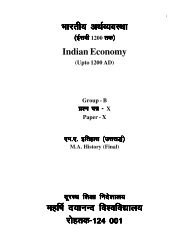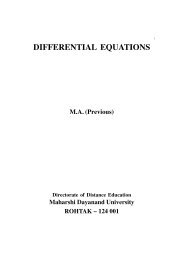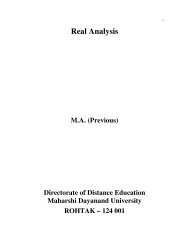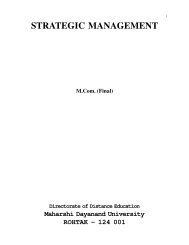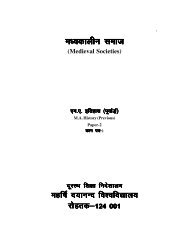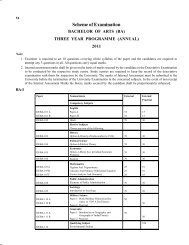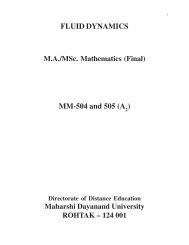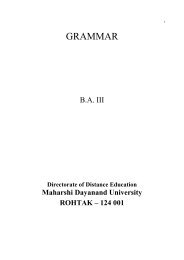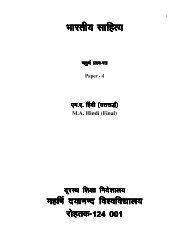LITERATURE AND GENDER - Maharshi Dayanand University, Rohtak
LITERATURE AND GENDER - Maharshi Dayanand University, Rohtak
LITERATURE AND GENDER - Maharshi Dayanand University, Rohtak
You also want an ePaper? Increase the reach of your titles
YUMPU automatically turns print PDFs into web optimized ePapers that Google loves.
Girish Karnad – Nagamandalare existential plays- continuing the absurdity of life with a new trend of the audience participating in the plays. Afounder member of the Third Theatre, he has contributed plays like ‘ Procession’, Bhoma and State News. One ofthe most popular plays ‘Procession’ deals with the search for a new house—a new society.Vijay Tendulkar, the Marathi stalwart, has taken up somewhat different themes and adopted a new style. Man’s lifeis marred by selfishness, rituperance, injustice and fear of failure and extinction. For this he shall assault, murder, useall his cunning for survival, having neither compassion nor scruples. He loathes and hurts and is incapable ofsacrifice. He shows man in stark nakedness, beyond redemption. Hence there is, in his plays no hope for reprieve.His popular plays, ‘ Silence the Court is in session! “ Sukharam Binder” and Ghashiram Kotwal” all deal with Man’sinability to change the social system of power games and gain, leading to man’s annihilation. The structure of life remainsunchanged and man after man falls prey to this demonic hold of those in power be it Man versus Woman or Ghashiramversus Nana. A sense of foreboding prevails in all plays lending it a touch of nihilism and maniacal depression.Naga Mandala, Hayavadana and YayatiKarnad’s Major PlaysGirish Karnad’s three plays, ‘ Yayati’, Hayavadana’ and ‘Naga Mandala’ have one thing in common, their themes areborrowed either from Indian myth or folklore.For his first play ‘ Yayati’, Karnad borrowed from Mahabharata, making drastic changes in the events to suit hispurpose and style. The episode of Yayati who unsatisfied, still craves for physical pleasures and borrows his sons’youth to quench his thirst is unique in Indian mythology—it has intrigued and enchanted the readers for centuries.Yayati’s story is symbolic of man’s attachment to life, youth and pleasure. Veena Noble Dass in her detailed analysisof the plays in “ Flowering of Indian Drama” points out the different motives and causes, which bring about a changein Yayati towards the end. She says, “ Karnad’s originality lay in working out the motivations behind Yayati’s ultimatechoice. In the Mahabharata, Yayati’s renunciation is the result of his recognition of the nature of desire itself; therealization that desire does not finish through fulfillment, it is by its very nature recurrent. In Karnad’s play it is aconsequence of a series of symbolic encounters, which lead to Yayati’s recognition of the horror of his own life andhis assumption of the moral responsibility for it”There are other innovations too. The character of ‘Sutradhar’ is introduced, who tells the historical perspective of theplays, its lineage to the Puranas, of the man who cannot change the predictable of his life- looking for alternatives isfutile- therefore, the morals about values of human life must be followed. There is no choice for a man but to grow old,no choice for a saint but to overcome the unavoidable path of sin and temptation. The ‘Sutradhar’ spells this theme thus:“ Sometimes as we are walking along a path we see two paths in front of us. We take one road, yet we still wonder, whatwould have happened—yet—let the untrodden road be untrodden and let its secret be buried. Whatever grandma’s storieswe have heard in our childhood let us stick to their morals. This is useful in our lives. Our play is also based on such a story”Sharmishtha, the traditional woman in the play sticks to her convictions, whereas Puru, the one who is in the beginningof the play a symbol of filial love becomes a symbol of wasted life towards the end. Karnad has in this play as in someothers like ‘Naga-Mandala’ tried to cater to the modern sensibility, connecting the mythical with the present. How farhe has succeeded in this is a matter of debate.Hayavadana is based on a story from Vetala, the story of the ‘Transposed Heads in the Sanskrit Vetala Panchavinshaneachof these stories poses a riddle at the end which Vetala challenges the King to solve.Padmini is married to Devadatta, a man of intellect. He has a friend Kapila, a man of the body. In the original storyPadmini interchanged the heads of her husband and brother, she wanted her husband to have both the beauty of mindand physique. After the heads have been transposed, the question was who was Padmini’s husband— when the ghostposed this difficult question to the King- this is what Trivikravasena says:“ that one of the two, on whom her husbands’ head was fixed, was her husband, for the head is thechief of limbs and personal identity depends on it”Bhagvata who is a predecessor of the Sutradhar in Sanskrit drama, announces not only the theme, the dilemma of41



